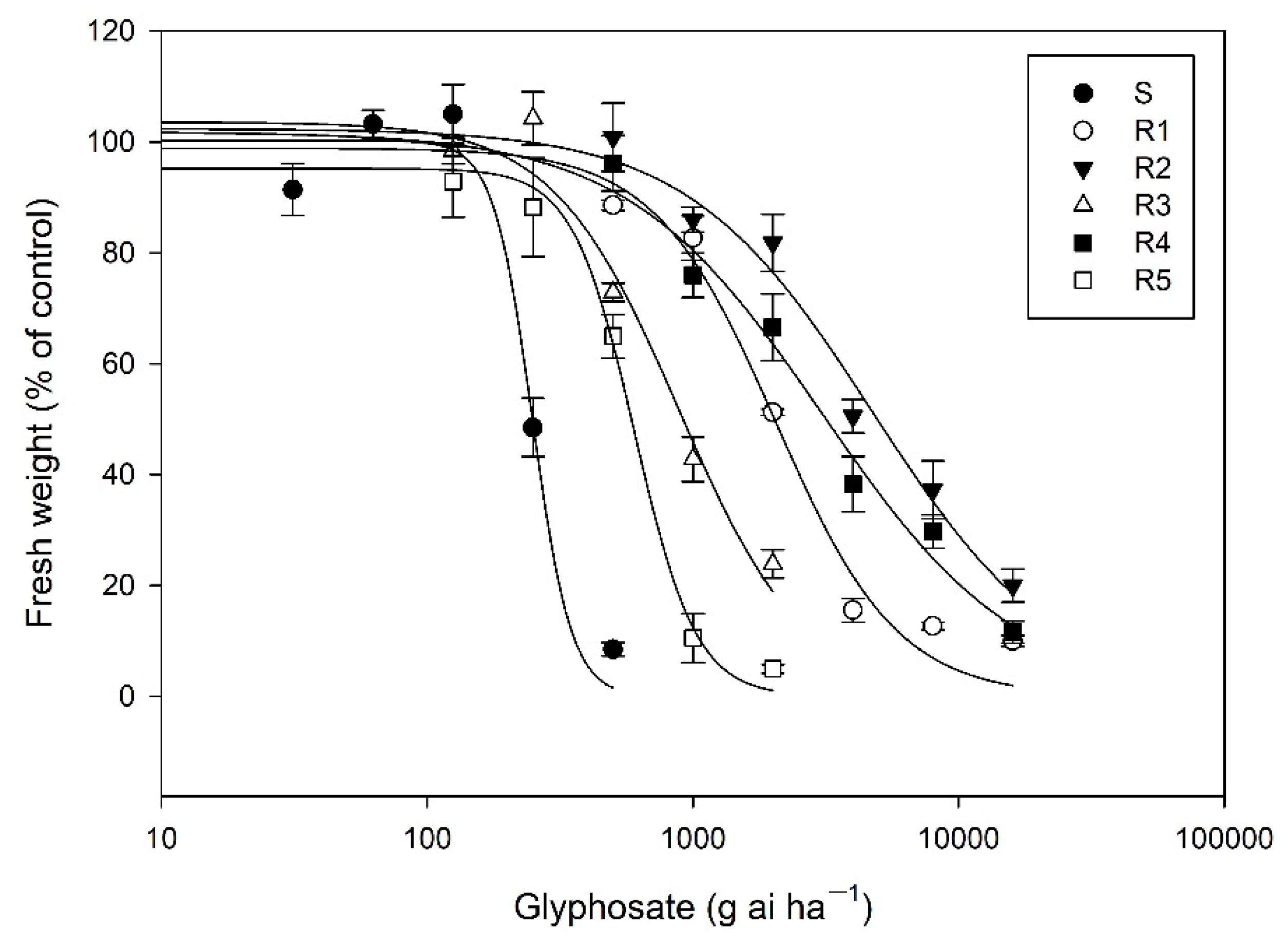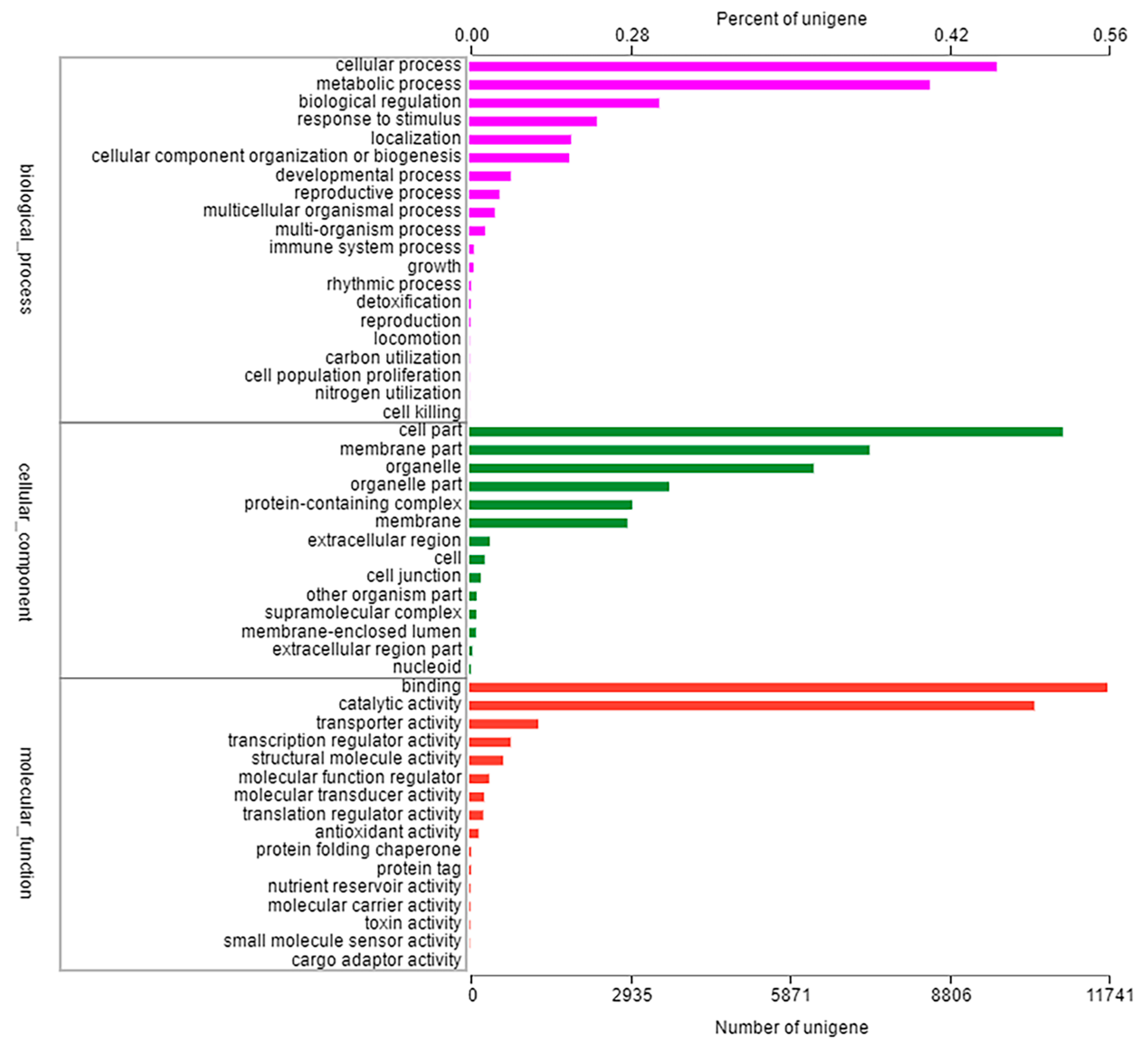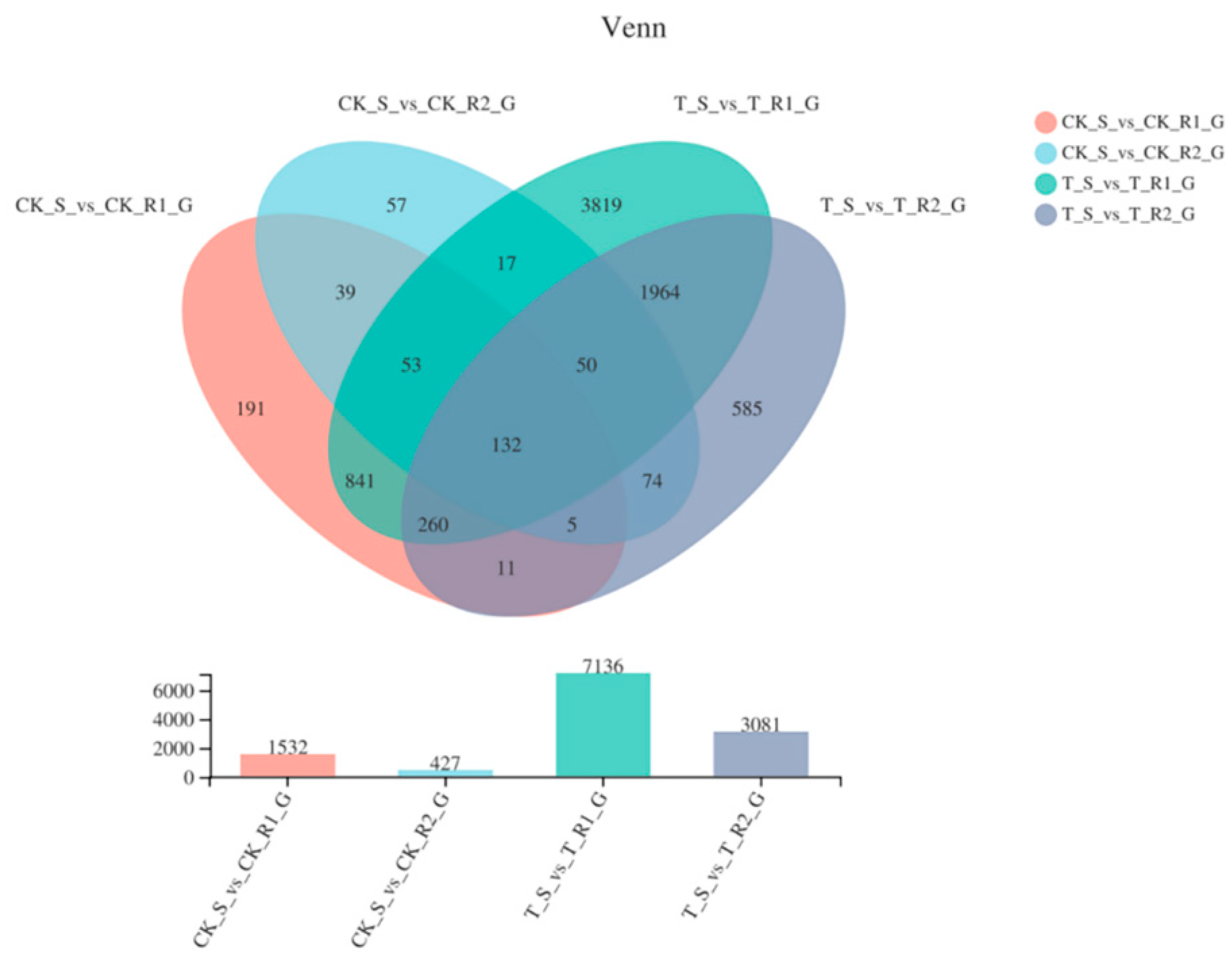Multiple Resistance Mechanisms Involved in Glyphosate Resistance in Eleusine indica
Abstract
1. Introduction
2. Results
2.1. Identification of Glyphosate Resistance in Five Resistant Biotypes
2.2. Detection of TSR Mechanisms
2.3. RNA-Seq and De Novo Assembly
2.4. Sequence Annotation and Classification
2.5. Identification of the Differentially Expressed Genes Involved in NTSR
2.6. RT-qPCR Validation of Candidate NTSR-Related Contigs
3. Discussion
4. Materials and Methods
4.1. Plant Materials and Whole-Plant Dose-Response to Glyphosate
4.2. EPSPS Sequencing and Expression
4.3. Sample Preparation for RNA-Seq
4.4. RNA-Seq
4.5. Selection and Validation of Candidate Non-Target Resistance Genes
Supplementary Materials
Author Contributions
Funding
Institutional Review Board Statement
Informed Consent Statement
Data Availability Statement
Conflicts of Interest
References
- Heap, I. The International Herbicide-Resistant Weed Database. Available online: http://www.weedscience.org (accessed on 1 July 2022).
- Powles, S.B.; Yu, Q. Evolution in action: Plants resistant to herbicides. Annu. Rev. Plant Biol. 2010, 61, 317–347. [Google Scholar] [CrossRef]
- Délye, C. Unravelling the genetic bases of non-target-site-based resistance (NTSR) to herbicides: A major challenge for weed science in the forthcoming decade. Pest Manag. Sci. 2013, 69, 176–187. [Google Scholar] [CrossRef]
- Yu, Q.; Powles, S.B. Resistance to AHAS inhibitor herbicides: Current understanding. Pest Manag. Sci. 2014, 70, 1340–1350. [Google Scholar] [CrossRef]
- Kaundun, S.S. Resistance to acety-CoA carboxylase-inhibiting herbicides. Pest Manag. Sci. 2014, 70, 1405–1417. [Google Scholar] [CrossRef]
- Sammons, R.D.; Gaines, T.A. Glyphosate resistance: State of knowledge. Pest Manag. Sci. 2014, 70, 1367–1377. [Google Scholar] [CrossRef]
- Délye, C.; Jasieniuk, M.; Le Corre, V. Deciphering the evolution of herbicide resistance in weeds. Trends Genet. 2013, 29, 649–658. [Google Scholar] [CrossRef]
- Yuan, J.S.; Tranel, P.J.; Stewart, C.N., Jr. Non-target-site herbicide resistance: A family business. Trends Plant Sci. 2007, 12, 6–13. [Google Scholar] [CrossRef]
- Lv, Z.; Zhao, M.; Wang, W.; Wang, Q.; Huang, M.; Li, C.; Lian, Q.; Xia, J.; Qi, J.; Xiang, C.; et al. Changing Gly311 to an acidic amino acid in the MATE family protein DTX6 enhances Arabidopsis resistance to the dihydropyridine herbicides. Mol. Plant 2021, 14, 2115–2125. [Google Scholar] [CrossRef]
- Steinrucken, H.C.; Amrhein, N. The herbicide glyphosate is a potent inhibitor of 5-enolpyruvylshikimic acid-3-phosphate synthase. Biochem. Biophys. Res. Commun. 1980, 94, 1207–1212. [Google Scholar] [CrossRef]
- Heap, I.; Duke, S.O. Overview of glyphosate-resistant weeds worldwide. Pest Manag. Sci. 2018, 74, 1040–1049. [Google Scholar] [CrossRef]
- Baerson, S.R.; Rodriguez, D.J.; Tran, M.; Feng, Y.; Biest, N.A.; Dill, G.M. Glyphosate-resistant goosegrass identification of a mutation in the target enzyme 5-enolpyruvylshikimate-3-phosphate synthase. Plant Physiol. 2002, 129, 1265–1275. [Google Scholar] [CrossRef]
- Cross, R.B.; McCarty, L.B.; Tharayil, N.; McElroy, J.S.; Chen, S.; McCullough, P.E.; Powell, B.A.; Bridge, W.C. A Pro106 to Ala substitution is associated with resistance to glyphosate in annual bluegrass (Poa annua). Weed Sci. 2015, 63, 613–622. [Google Scholar] [CrossRef]
- Loddo, D.; Imperatore, G.; Milani, A.; Panozzo, S.; Farinati, S.; Sattin, M.; Zanin, G. First report of glyphosate-resistant biotype of Eleusine Indica (L.) Gaertn. in Europe. Agronomy 2020, 10, 1692. [Google Scholar] [CrossRef]
- Yanniccari, M.; Vázquez-García, J.G.; Gigón, R.; Palma-Bautista, C.; Vila-Aiub, M.; De Prado, R. A novel EPSPS Pro-106-His mutation confers the first case of glyphosate resistance in Digitaria sanguinalis. Pest Manag. Sci. 2022, 78, 3135–3143. [Google Scholar] [CrossRef]
- McElroy, J.S.; Hall, N.D. Echinochloa colona with reported resistance to glyphosate conferred by aldo-keto reductase also contains a Pro-106-Thr EPSPS target site mutation. Plant Physiol. 2020, 183, 447–450. [Google Scholar] [CrossRef]
- Li, J.; Peng, Q.; Han, H.; Nyporko, A.; Kulynych, T.; Yu, Q.; Powles, S.B. Glyphosate resistance in Tridax procumbens via a novel EPSPS Thr-102-Ser substitution. J. Agric. Food Chem. 2018, 66, 7880–7888. [Google Scholar] [CrossRef]
- Takano, H.K.; Fernandes, V.N.; Adegas, F.S.; Oliveira Jr, R.S.; Westra, P.; Gaines, T.A.; Dayan, F.E. A novel TIPT double mutation in EPSPS conferring glyphosate resistance in tetraploid Bidens subalternans. Pest Manag. Sci. 2020, 76, 95–102. [Google Scholar] [CrossRef]
- Mendes, R.R.; Takano, H.K.; Leal, J.F.; Souza, A.S.; Morran, S.; Oliveira, R.S., Jr.; Adegas, F.S.; Gaines, T.A.; Dayan, F.K. Evolution of EPSPS double mutation imparting glyphosate resistance in wild poinsettia (Euphorbia heterophylla L.). PLoS ONE 2020, 15, e0238818. [Google Scholar] [CrossRef]
- Perotti, V.E.; Larran, A.S.; Palmieri, V.E.; Martinatto, A.K.; Alvarez, C.E.; Tuesca, D.; Permingeat, H.R. A novel triple amino acid substitution in the EPSPS found in a high-level glyphosate resistant Amaranthus hybridus population from Argentina. Pest Manag. Sci. 2019, 75, 1242–1251. [Google Scholar] [CrossRef]
- Dominguez-Valenzuela, J.A.; Gherekhloo, J.; Fernández-Moreno, P.T.; Cruz-Hipolito, H.E.; Alcántara-de la Cruz, R.; Sánchez-González, E.; De Prado, R. First confirmation and characterization of target and non-target site resistance to glyphosate in Palmer amaranth (Amaranthus palmeri) from Mexico. Plant Physiol. Biochem. 2017, 115, 212–218. [Google Scholar] [CrossRef]
- Ge, X.; d’Avignon, D.A.; Ackerman, J.J.; Collavo, A.; Sattin, M.; Ostrander, E.L.; Hall, E.L.; Sammons, R.D.; Preston, C. Vacuolar glyphosate-sequestration correlates with glyphosate resistance in ryegrass (Lolium spp.) from Australia, South America, and Europe: A 31P NMR investigation. J. Agric. Food Chem. 2012, 60, 1243–1250. [Google Scholar] [CrossRef]
- Palma-Bautista, C.; Torra, J.; Garcia, M.J.; Bracamonte, E.; Rojano-Delgado, A.M.; Alcántara-de la Cruz, R.; De Prado, R. Reduced absorption and impaired translocation endows glyphosate resistance in Amaranthus palmeri harvested in glyphosate-resistant soybean from Argentina. J. Agric. Food Chem. 2019, 67, 1052–1060. [Google Scholar] [CrossRef]
- Piasecki, C.; Yang, Y.; Benemann, D.P.; Kremer, F.S.; Galli, V.; Millwood, R.J.; Cechin, J.; Agostinetto, D.; Maia, L.C.; Vargas, L.; et al. Transcriptomic analysis identifies new non-target site glyphosate-resistance genes in Conyza bonariensis. Plants 2019, 8, 157. [Google Scholar] [CrossRef]
- Page, E.R.; Grainger, C.M.; Laforest, M.; Nurse, R.E.; Rajcan, I.; Bae, J.; Tardif, F.J. Target and non–target site mechanisms confer resistance to glyphosate in Canadian accessions of Conyza canadensis. Weed Sci. 2018, 66, 234–245. [Google Scholar] [CrossRef]
- AlcaNtara-De La Cruz, R.; Fernández-Moreno, P.T.; Ozuna, C.V.; Rojano-Delgado, A.M.; Cruz-Hipolito, H.E.; Domínguez-Valenzuela, J.A.; De Prado, R. Target and non-target site mechanisms developed by glyphosate-resistant hairy beggarticks (Bidens pilosa L.) populations from Mexico. Front. Plant Sci. 2016, 7, 1492. [Google Scholar] [CrossRef]
- Chen, J.C.; Huang, H.J.; Wei, S.H.; Cui, H.L.; Li, X.J.; Zhang, C.X. Glyphosate resistance in Eleusine indica: EPSPS overexpression and P106A mutation evolved in the same individuals. Pestic. Biochem. Physiol. 2020, 164, 203–208. [Google Scholar] [CrossRef]
- Zhang, C.; Yu, C.J.; Yu, Q.; Guo, W.L.; Zhang, T.J.; Tian, X.S. Evolution of multiple target-site resistance mechanisms in individual plants of glyphosate-resistant Eleusine indica from China. Pest Manag. Sci. 2021, 77, 4810–4817. [Google Scholar] [CrossRef]
- Pan, L.; Yu, Q.; Han, H.; Mao, L.; Nyporko, A.; Fan, L.; Bai, L.; Powles, S. Aldo-keto reductase metabolizes glyphosate and confers glyphosate resistance in Echinochloa colona. Plant Physiol. 2019, 181, 1519–1534. [Google Scholar] [CrossRef]
- Pan, L.; Yu, Q.; Wang, J.; Han, H.; Mao, L.; Nyporko, A.; Maguza, A.; Fan, L.; Bai, L.; Powles, S. An ABCC-type transporter endowing glyphosate resistance in plants. Proc. Natl. Acad. Sci. USA 2021, 118, e2100136118. [Google Scholar] [CrossRef]
- Lee, L.J.; Ngim, J. A first report of glyphosate-resistant goosegrass (Eleusine indica (L.) Gaertn) in Malaysia. Pest Manag. Sci. 2000, 56, 336–339. [Google Scholar] [CrossRef]
- Kaundun, S.; Zelaya, I.; Dale, R.; Lycett, A.J.; Carter, P.; Sharples, K.R.; McIndoe, E. Importance of the P106S target-site mutation in conferring resistance to glyphosate in a goosegrass (Eleusine indica) population from the Philippines. Weed Sci. 2008, 56, 637–646. [Google Scholar] [CrossRef]
- Mueller, T.; Barnett, K.; Brosnan, J.; Steckel, L.E. Glyphosate-resistant goosegrass (Eleusine indica) confirmed in Tennessee. Weed Sci. 2011, 59, 562–566. [Google Scholar] [CrossRef]
- Yang, C.H.; Tian, X.S.; Feng, L.; Yue, M.F. Glyphosate resistance to Eleusine indica. Chin. Agric. Sci. 2012, 45, 2093–2098. [Google Scholar]
- Vargas, L.; Ulguim, A.R.; Agostinetto, D.; Magro, T.D.; Thürmer, L. Low level resistance of goosegrass (Eleusine indica) to glyphosate in Rio Grande do Sul-Brazil. Planta Daninha 2013, 31, 677–686. [Google Scholar] [CrossRef][Green Version]
- Yu, Q.; Jalaludin, A.; Han, H.; Chen, M.; Sammons, R.D.; Powles, S.B. Evolution of a double amino acid substitution in the 5-enolpyruvylshikimate-3-phosphate synthase in Eleusine indica conferring high-level glyphosate resistance. Plant Physiol. 2015, 167, 1440–1447. [Google Scholar] [CrossRef]
- Brunharo, C.A.D.C.G.; Morran, S.; Martin, K.; Moretti, M.L.; Hanson, B.D. EPSPS duplication and mutation involved in glyphosate resistance in the allotetraploid weed species Poa annua L. Pest Manag. Sci. 2019, 75, 1663–1670. [Google Scholar] [CrossRef]
- Conte, S.S.; Lloyd, A.M. Exploring multiple drug and herbicide resistance in plants-spotlight on transporter proteins. Plant Sci. 2011, 180, 196–203. [Google Scholar] [CrossRef]
- Rea, P.A. Plant ATP-binding cassette transporters. Annu. Rev. Plant Biol. 2007, 58, 347–375. [Google Scholar] [CrossRef]
- Windsor, B.; Roux, S.; Lloyd, A. Multiherbicide tolerance conferred by AtPgp1 and apyrase overexpression in Arabidopsis thaliana. Nat. Biotechnol. 2003, 21, 428–433. [Google Scholar] [CrossRef]
- Peng, Y.; Abercrombie, L.L.; Yuan, J.S.; Riggins, C.W.; Sammons, R.D.; Tranel, P.J.; Stewart, C.N., Jr. Characterization of the horseweed (Conyza canadensis) transcriptome using GS-FLX 454 pyrosequencing and its application for expression analysis of candidate no-target herbicide resistance genes. Pest Manag. Sci. 2010, 66, 1053–1062. [Google Scholar] [CrossRef]
- Krishnamurthy, P.; Pothiraj, R.; Suthanthiram, B.; Somasundaram, S.M.; Subbaraya, U. Phylogenomic classification and synteny network analyses deciphered the evolutionary landscape of aldo–keto reductase (AKR) gene superfamily in the plant kingdom. Gene 2022, 816, 146169. [Google Scholar] [CrossRef] [PubMed]
- Fitzgibbon, J.E.; Braymer, H.D. Cloning of a gene from Pseudomonas sp. strain PG2982 conferring increased glyphosate resistance. Appl. Environ. Microbiol. 1990, 56, 3382–3388. [Google Scholar] [CrossRef]
- Vemanna, R.S.; Vennapusa, A.R.; Easwaran, M.; Chandrashekar, B.K.; Rao, H.; Ghanti, K.; Sudhakar, C.; Mysore, K.S.; Makarla, U. Aldo-keto reductase enzymes detoxify glyphosate and improve herbicide resistance in plants. Plant Biotechnol. J. 2017, 15, 794–804. [Google Scholar] [CrossRef]
- de Carvalho, L.B.; Alves, P.L.; González-Torralva, F.; Cruz-Hipolito, H.E.; Rojano-Delgado, A.M.; De Prado, R.; Gil-Humanes, J.; Barro, F.; de Castro, M.D. Pool of resistance mechanisms to glyphosate in Digitaria insularis. J. Agric. Food Chem. 2012, 60, 615–622. [Google Scholar] [CrossRef]
- González-Torralva, F.; Rojano-Delgado, A.M.; de Luque Castro, M.D.; Mülleder, N.; De Prado, R. Two non-target mechanisms are involved in glyphosate-resistant horseweed (Conyza canadensis L. Cronq.) biotypes. J. Plant Physiol. 2012, 169, 1673–1679. [Google Scholar] [CrossRef]
- Saika, H.; Horita, J.; Taguchi-Shiobara, F.; Nonaka, S.; Nishizawa-Yokoi, A.; Iwakami, S.; Hori, K.; Matsumoto, T.; Tanaka, T.; Itoh, T.; et al. A novel rice cytochrome P450 gene, CYP72A31, confers tolerance to acetolactate synthase-inhibiting herbicides in rice and Arabidopsis. Plant Physiol. 2014, 166, 1232–1240. [Google Scholar] [CrossRef]
- Han, H.; Yu, Q.; Beffa, R.; González, S.; Maiwald, F.; Wang, J.; Powles, S.B. Cytochrome P450 CYP81A10v7 in Lolium rigidum confers metabolic resistance to herbicides across at least five modes of action. Plant J. 2021, 105, 79–92. [Google Scholar] [CrossRef]
- Pan, L.; Guo, Q.; Wang, J.; Shi, L.; Yang, X.; Zhou, Y.; Yu, Q.; Bai, L. CYP81A68 confers metabolic resistance to ALS and ACCase-inhibiting herbicides and its epigenetic regulation in Echinochloa crus-galli. J. Hazard. Mater. 2022, 428, 128225. [Google Scholar] [CrossRef]
- Abdollahi, F.; Alebrahim, M.T.; Ngov, C.; Lallemand, E.; Zheng, Y.; Villette, C.; Zumsteg, J.; André, F. Innate promiscuity of the CYP706 family of P450 enzymes provides a suitable context for the evolution of dinitroaniline resistance in weed. New Phytol. 2021, 229, 3253–3268. [Google Scholar] [CrossRef]



| Biotypes | Geographical Location | GR50 | RI |
|---|---|---|---|
| S | 32.36° N, 119.40° E | 248.7 ± 13.6 | 1.0 |
| R1 | 32.56° N, 119.53° E | 2138.6 ± 213.7 | 8.6 |
| R2 | 32.33° N, 119.52° E | 4763.9 ± 637.7 | 19.2 |
| R3 | 32.54° N, 119.22° E | 884.2 ± 122.8 | 3.5 |
| R4 | 32.63° N, 119.37° E | 3531.9 ± 339.7 | 14.2 |
| R5 | 32.30° N, 119.41° E | 602.9 ± 33.5 | 2.4 |
| Biotypes | TSR Mechanisms | |
|---|---|---|
| EPSPS Mutations | EPSPS Expression | |
| S | No mutations | 1 |
| R1 | No mutations | 22.4 ± 7.3 |
| R2 | No mutations | 39.0 ± 15.6 |
| R3 | Pro-106-Ala | 2.5 ± 0.8 |
| R4 | Thr-102-Ile + Pro-106-Ile (heterozygotes) | 1.7 ± 0.5 |
| R5 | No mutations | 54.1 ± 6.1 |
| Gene ID | Function Annotation | Fold Change: RNA-Seq | Fold Change: RT-qPCR Validation | ||||||
|---|---|---|---|---|---|---|---|---|---|
| CK-S/CK-R1 | CK-S/CK-R2 | T-S/T-R1 | T-S/T-R2 | CK-S/CK-R1 | CK-S/CK-R2 | T-S/T-R1 | T-S/T-R2 | ||
| DN8045_c0 | ABC transporter, ABCB2 | 8.3 * | 7.3 * | 3.1 * | 2.0 | 1.0 | 0.8 | — | — |
| DN2269_c0 | ABC transporter, ABCC4 | 20.6 * | 9.0 * | 15.0 * | 9.6 * | 36.3 * | 18.4 * | 137.6 * | 101.1 * |
| DN17118_c0_g2 | ABC transporter, ABCG50 | 2.6 * | 1.5 | 1.9 | 1.1 | 1.7 | 0.9 | — | — |
| DN11662_c0_g1 | ABC transporter, ABCG11 | 9.9 * | 1.1 | 1.4 | 0.7 | 3.1 * | 1.4 | — | — |
| DN12056_c0_g1 | ABC transporter, ABCA | 6.1 * | 2.1 | 2.3 | 0.5 | 0.9 | 0.4 | — | — |
| DN9447_c0 | Aldo-keto reductase, AKR4C10 | 1.4 | 1.4 | 2.8 * | 3.7 * | 1.7 | 1.8 | 3.1 * | 3.4 * |
| DN10234_c1 | Aldo-keto reductase, AKR2 | 3.1 * | 1.0 | 2.4 * | 0.6 | 6.0 * | 1.4 | — | — |
| DN4583_c0_g2 | CytP450, CYP88 | 1.5 | 3.3 * | 3.4 * | 6.0 * | 2.8 * | 3.4 * | 0.9 | 3.0 * |
| DN14280_c0_g1 | CytP450, CYP89 | 6.1 * | 2.9 | 8.9 * | 5.5 * | 1.3 | 0.8 | 0.4 | 0.9 |
| DN879_c0_g1 | GST1 | 5.1 * | 1.2 | 4.1 * | 1.1 | 0.6 | 0.7 | — | — |
Publisher’s Note: MDPI stays neutral with regard to jurisdictional claims in published maps and institutional affiliations. |
© 2022 by the authors. Licensee MDPI, Basel, Switzerland. This article is an open access article distributed under the terms and conditions of the Creative Commons Attribution (CC BY) license (https://creativecommons.org/licenses/by/4.0/).
Share and Cite
Deng, W.; Duan, Z.; Li, Y.; Peng, C.; Yuan, S. Multiple Resistance Mechanisms Involved in Glyphosate Resistance in Eleusine indica. Plants 2022, 11, 3199. https://doi.org/10.3390/plants11233199
Deng W, Duan Z, Li Y, Peng C, Yuan S. Multiple Resistance Mechanisms Involved in Glyphosate Resistance in Eleusine indica. Plants. 2022; 11(23):3199. https://doi.org/10.3390/plants11233199
Chicago/Turabian StyleDeng, Wei, Zhiwen Duan, Yang Li, Cheng Peng, and Shuzhong Yuan. 2022. "Multiple Resistance Mechanisms Involved in Glyphosate Resistance in Eleusine indica" Plants 11, no. 23: 3199. https://doi.org/10.3390/plants11233199
APA StyleDeng, W., Duan, Z., Li, Y., Peng, C., & Yuan, S. (2022). Multiple Resistance Mechanisms Involved in Glyphosate Resistance in Eleusine indica. Plants, 11(23), 3199. https://doi.org/10.3390/plants11233199









